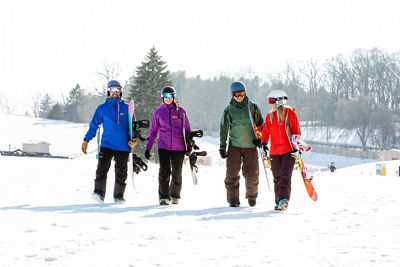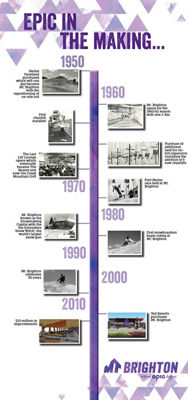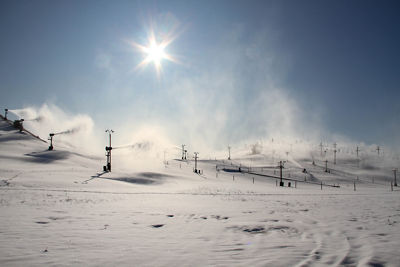About Mt. Brighton

History of Mt. Brighton
Since 1960, Mt. Brighton Ski Area in Southeast Michigan has been an uplifting family winter destination on the Midwest snow sports scene. Skiers and riders from Detroit, Ann Arbor, Lansing and Northwest Ohio can easily access 25 trails and five lifts covering 130 acres.
Having converted thousands of first-timers into lifelong skiers and riders, and now with the opportunity to take that passion to Vail Resorts’ iconic western mountains, Mt. Brighton is truly the place where Epic begins.

The Uplifting Story of Mt. Brighton
1950s: Herbst Farmland purchased which will one day become Mt. Brighton with the repositioning of the on-site soil.
1960s: Mt. Brighton open for the 1960/61 season with one J-Bar. Purchase of additional land for on-hill expansion including the addition of 5 new chairlifts.
1970s: The Last Lift Lounge opens which eventually became the Bauery and now Ore Creek Mountain Grill. First Nastar race held at Mt. Brighton.
1980’s: Mt. Brighton known as the Snowmaking Capital with the Schneehex ‘Snow Witch’ the world’s largest snow gun. First snowboarders begin riding at Mt. Brighton.
2000’s: Mt. Brighton celebrates 50 years. Happy birthday!
2015: Vail purchase Mt. Brighton, which included $10 million in improvements.

Snow making Capabilities
Mt. Brighton is committed to the best snow making capabilities, including an expansion, which triple the capacity. The new system will allow the ski area to open sooner with a greater base, higher quality snow surface and the ability to recover more quickly from a weather event.
The ski area has 43 new, energy-efficient snow making guns; 17,000 feet of higher capacity snow making pipe; 92 new snow making hydrants; and a new automated pump house that will nearly triple the capacity of water pumped per minute through the snow guns.
Snowmaking 101
Hey there everyone! As winter approaches and we all feel that familiar chill in the air, for many of us waiting to take those first turns on the mountain the snow can’t ever seem to come soon enough. We often hear questions about snowmaking such as “How do you make snow?” or “It was freezing last night, why didn’t you blow any snow?” Believe us- we want winter to come sooner than anyone! Since Mother Nature doesn’t always cooperate, every year we have to rely on the heroes of the ski and snowboard industry, our SNOWMAKERS! Our top goal is to produce the highest snow quality you can find anywhere, so to help you get a better understanding of the optimal conditions needed to produce snow, our team has put together the following Snowmaking 101. Enjoy!
Snowmaking FAQ
Snowmaking can be a very complex process with many components playing a role in determining whether or not snow can successfully be made. In the simplest terms, snowmaking is the process of turning water into small ice crystals (or snow). Cold water is pumped through a snow gun using compressed air, allowing the water to be separated into small particles and cooled by outside temperatures. For this to happen, a number of things must be taken into account including ambient temperatures and relative humidity (together called wet-bulb temperature), water temperatures, ambient ground temperatures and the extended forecast.
The first component of great snowmaking is cold weather. The ambient (or surrounding) temperature must be at most 28°F. The second component, and equally as important as temperature, is the relative humidity. Even when temperatures outside are 28°F, snow making and snow quality can still be poor (or not even possible) if the humidity remains high. This is usually the toughest variable in Michigan where we often have humidity in the 50-70% range, making the teens to low-20s the optimal snowmaking temps. In cases of higher humidity, water is not capable of turning into the frozen state or even staying frozen. As a general rule of thumb, low temps and low humidity produce the ideal conditions of snowmaking.
At Mt. Brighton, we draw our water for snowmaking from our pond, which is pumped through hundreds of yards of pipe to our pump house, which distributes the water across the resort to our various snow guns. We all know that water freezes at 32F, but in order to make good quality snow, the water pumped through the snow guns must also be close to freezing. Imagine how much longer it would take a cup of boiling water to freeze compared to a cup of ice water, the same can be said for snowmaking; the lower the water temperature, the better chance of making quality snow.
As the seasons change from summer to fall, and fall to winter we immediately feel the change in temperatures, but it takes much more time for the ground to be impacted by the changing seasons. During the summer months, the ground stores the energy and heat from the sun which can radiate long into fall and even winter. As our snowmakers begin to assess all the conditions affecting the snowmaking process, they must also consider the ambient ground temperature. Even if wet-bulb temperatures and water temperatures are optimal, when the ground temperatures are too high, the snow that gets made will melt once it falls onto the ground. The longer we have cold temperatures, the better chance the ground has to freeze and retain the snow made by our snowmakers.
Ask anyone who is passionate about skiing or snowboarding and they’ll tell you how hard it is to wait for fall to transition to winter. One week it’s cold. The next week it's warm. That’s why it’s critical for our snowmakers to watch the weather forecast for stretches of optimal snowmaking conditions long enough to ensure that the snow they make will actually stick around. A temperature dip into the mid-20s can tease winter, only to jump up into the 40s and 50s the next day and melt away all that hard work. The most important component of successful early-season snowmaking is a long, steady, cold forecast!

